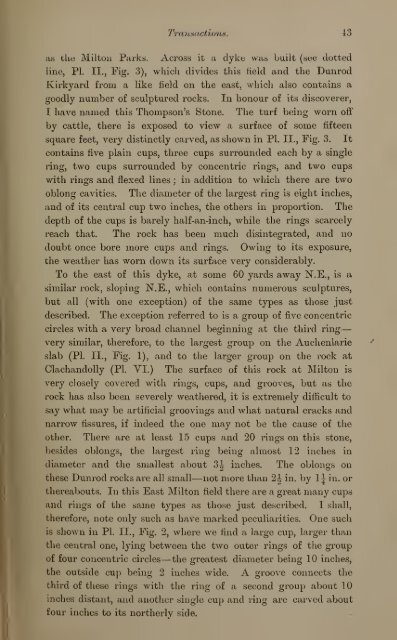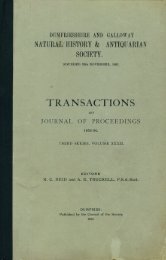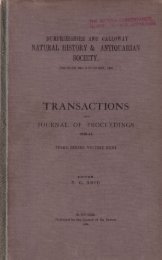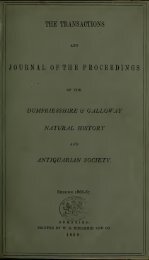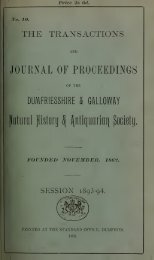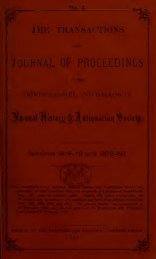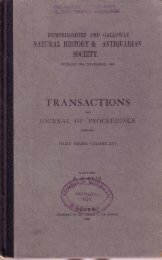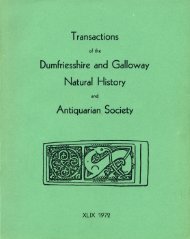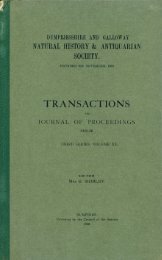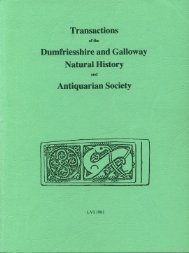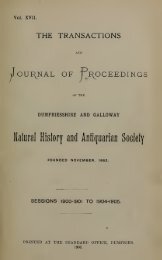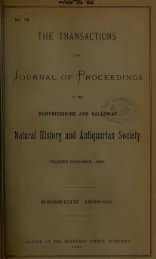Vol 5 - Dumfriesshire & Galloway Natural History and Antiquarian ...
Vol 5 - Dumfriesshire & Galloway Natural History and Antiquarian ...
Vol 5 - Dumfriesshire & Galloway Natural History and Antiquarian ...
Create successful ePaper yourself
Turn your PDF publications into a flip-book with our unique Google optimized e-Paper software.
—Transactions.'43as the Milton Parks. Across it a dyke was built (see dottedline, PI. II., Fig. 3), which divides this field <strong>and</strong> the DunrodKirkyard from a like field on the east, which also contains agoodly number of sculptured I'ocks. In honour of its discoverer,I have named this Thompson's Stone. The turf being worn offby cattle, there is exposed to view a surface of some fifteensquare feet, very distinctly carved, as shown in PI. II., Fig. 3. Itcontains five plain cups, three cups surrounded each by a singlering, two cups surrounded by concentric rings, <strong>and</strong> two cupswith rings <strong>and</strong> flexed lines ; in addition to which there are twooblong cavities. The diameter of the largest ring is eight inches,<strong>and</strong> of its central cup two inches, the others in proportion. Thedepth of the cups is barely half-an-inch, while the rings scarcelyreach that. The rock has been much disintegrated, <strong>and</strong> nodoubt once bore more cups <strong>and</strong> rings. Owing to its exposure,the weather has worn down its surface very considerably.To the east of this dyke, at some 60 yards away N.E., is asimilar rock, sloping N.E., which containsnumerous sculptures,but all (with one exception) of the same types as those justdescribed. The exception referred to is a group of five concentriccircles with a very broad channel beginning at the thii-d ringvery similar, therefore, to the largest grouj) on the Auchenlarieslab (PI. II., Fig. 1), <strong>and</strong> to the larger group on the rock atClach<strong>and</strong>oUy (PI. VI.) The surface of this rock at Milton isvery closely covered with rings, cups, <strong>and</strong> grooves, but as therock has also been severely weathered, it is extremely difficult tosay what may be artificial groovings <strong>and</strong> what natural cracks <strong>and</strong>narrow fissures, if indeed the one may not be the cause of theother. There are at least 1-5 cups <strong>and</strong> 20 rings on this stone,besides oblongs, the largest ring being almost 12 inches indiameter <strong>and</strong> the smallest about 3| inches. The oblongs onthese Duni'od rocks are all small—not more than 2^ in. by 1 ^ in. orthereabouts. In this East Milton field there are a great many cups<strong>and</strong> rings of the same types as those just described. I shall,therefore, note only such as have marked peculiarities. One suchis shown in PI. II., Fig. 2, where we find a large cup, larger thanthe central one, lying between the two outer rings of the groupof four concentric circles— the greatest diameter being 10 inches,the outside cuji being 2 inches wide. A groove connects thethird of these rings with the ring of a second group about 10inches distant, <strong>and</strong> anotlier single cup <strong>and</strong> ringfour inches to its northerly side.are carved about


